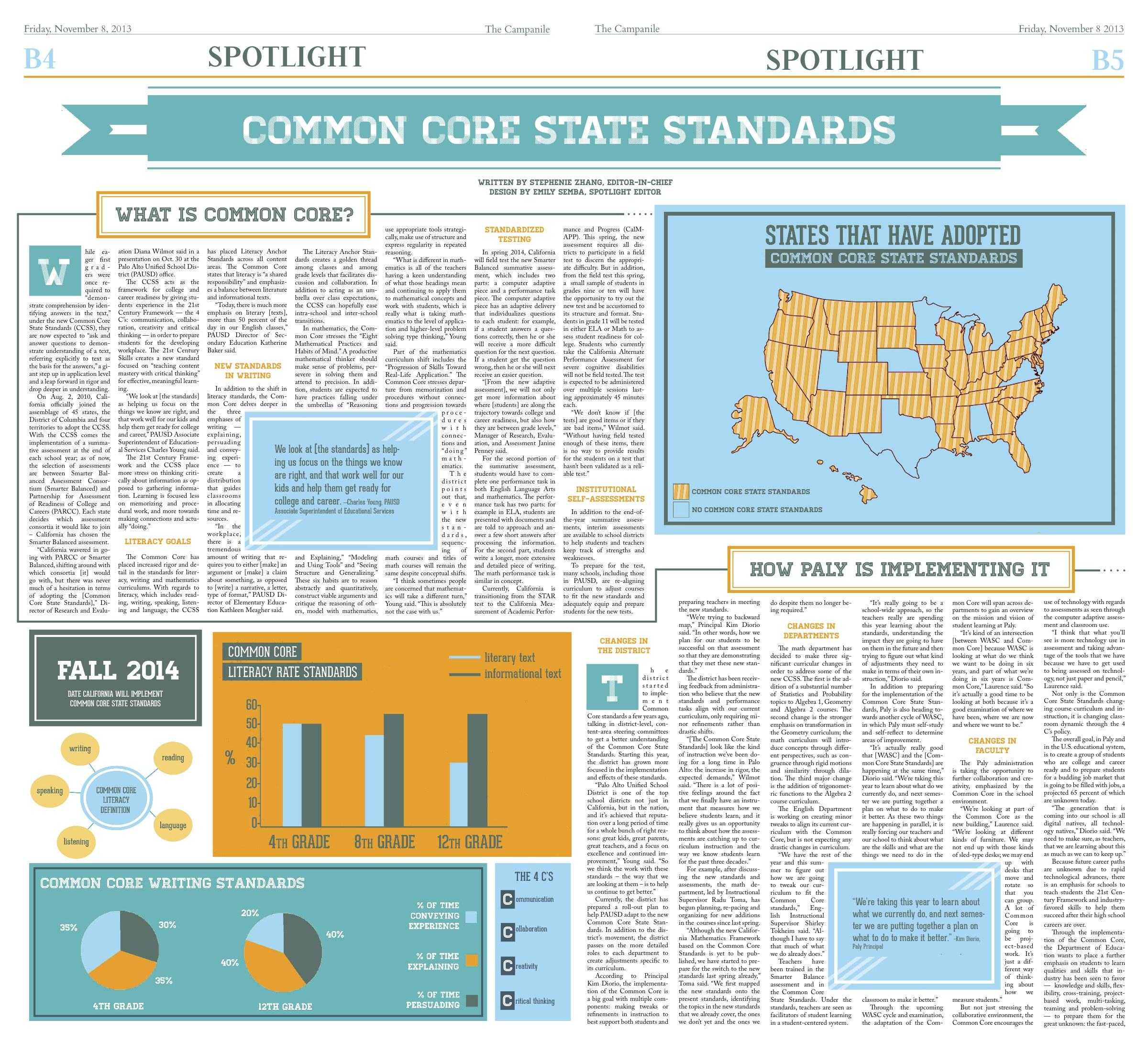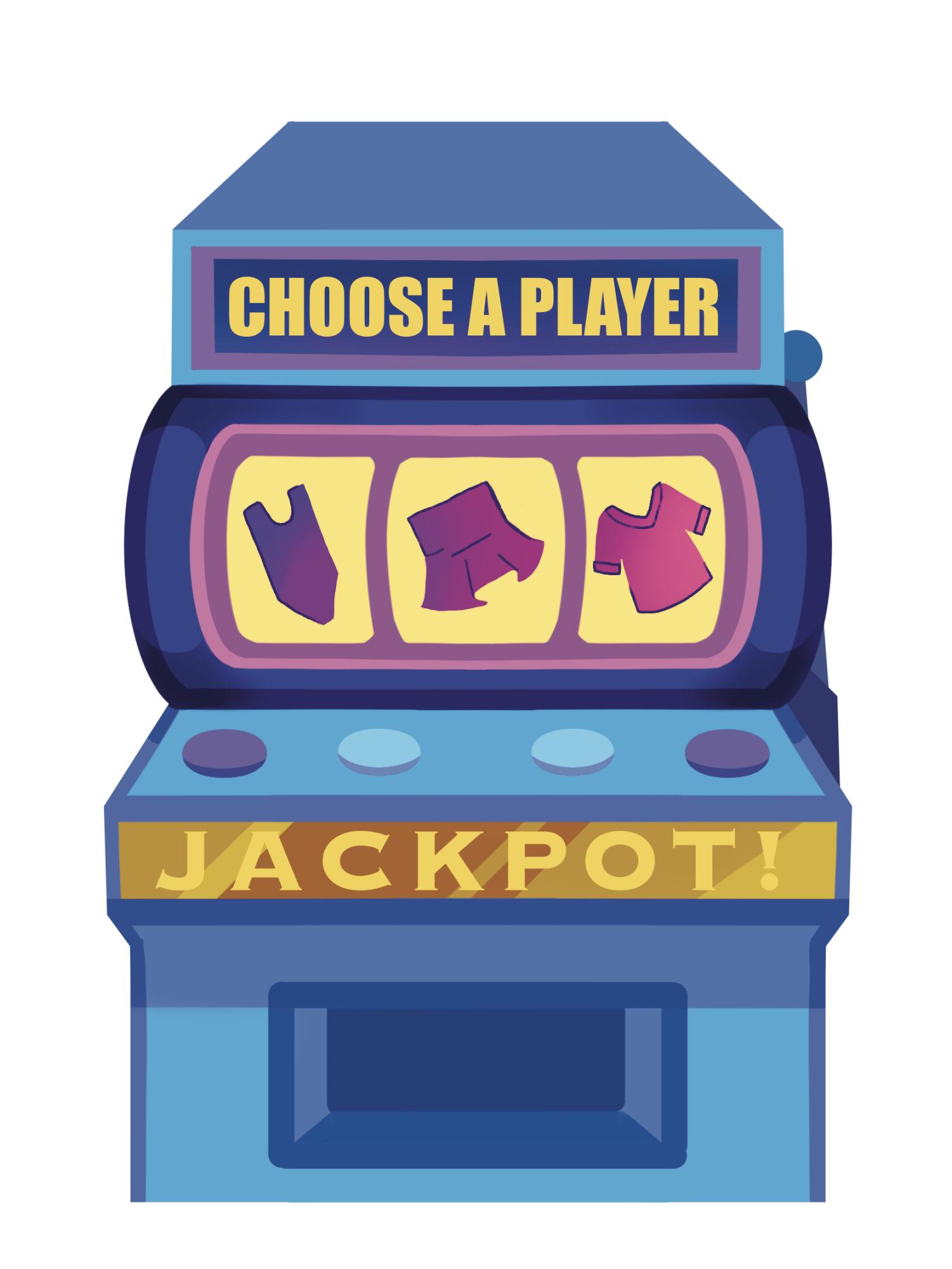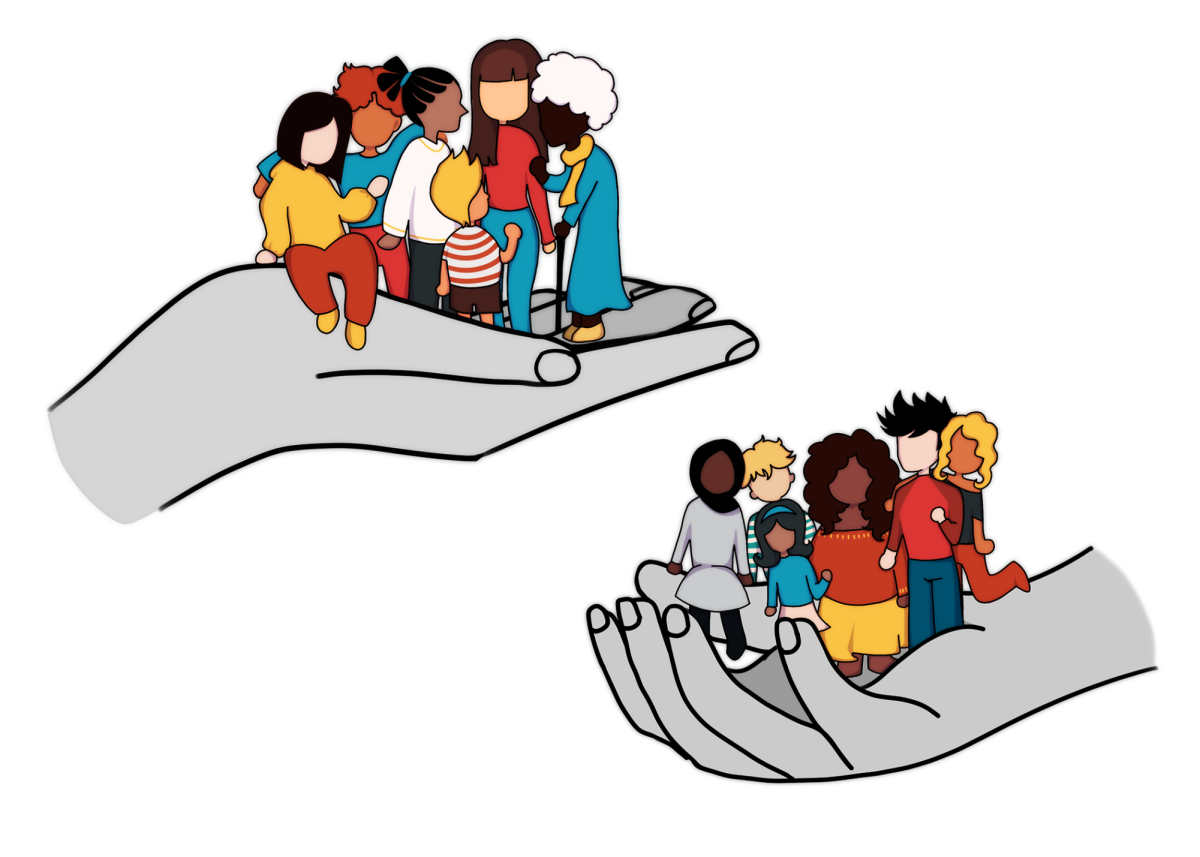What is the Common Core?
While eager first graders were once required to “demonstrate comprehension by identifying answers in the text,” under the new Common Core State Standards (CCSS), they are now expected to “ask and answer questions to demonstrate understanding of a text, referring explicitly to text as the basis for the answers,” a giant step up in application level, a leap forward in rigor and a drop deeper in understanding.
On Aug. 2, 2010, California officially joined the assemblage of 45 states, the District of Columbia and four territories to adopt the CCSS. With the CCSS comes the implementation of a summative assessment at the end of each school year; as of now, the selection of assessments are between Smarter Balanced Assessment Consortium (Smarter Balanced) and Partnership for Assessment of Readiness of College and Careers (PARCC). Each state decides which assessment consortia it would like to join – California has chosen the Smarter Balanced assessment.
“California wavered in going with PARCC or Smarter Balanced, shifting around with which consortia [it] would go with, but there was never much of a hesitation in terms of adopting the [Common Core State Standards},” Director of Research and Evaluation Diana Wilmot said in a presentation on Oct. 30 at the Palo Alto Unified School District (PAUSD) office.
The CCSS acts as the framework for college and career readiness by giving students experience in the 21st Century Framework — the 4 C’s: communication, collaboration, creativity and critical thinking — in order to prepare students for the developing workplace. The 21st Century Skills creates a new standard focused on “teaching content mastery with critical thinking” for effective, meaningful learning.
“We look at [the standards] as helping us focus on the things we know are right, and that work well for our kids and help them get ready for college and career,” PAUSD Associate Superintendent of Educational Services Charles Young said.
The 21st Century Framework and the CCSS place more stress on thinking critically about information as opposed to gathering information. Learning is focused less on memorizing and procedural work, and more towards making connections and actually “doing.”
Literacy Goals
The Common Core has placed increased rigor and detail in the standards for literacy, writing and mathematics curriculums. With regards to literacy, which includes reading, writing, speaking, listening and language, the CCSS has placed Literacy Anchor Standards across all content areas. The Common Core states that literacy is “a shared responsibility” and emphasizes a balance between literature and informational texts.
“Today, there is much more emphasis on literary [texts], more than 50 percent of the day in our English classes,” PAUSD Director of Secondary Education Katherine Baker said.
New Standards in Writing
In addition to the shift in literacy standards, the Common Core delves deeper in the three emphases of writing — explaining, persuading and conveying experience — to create a distribution that guides classrooms in allocating time and resources.
“In the workplace, there is a tremendous amount of writing that requires you to either [make] an argument or [make] a claim about something, as opposed to [write] a narrative, a letter, type of format,” PAUSD Director of Elementary Education Kathleen Meagher said.
The Literacy Anchor Standards creates a golden thread among classes and among grade levels that facilitates discussion and collaboration. In addition to acting as an umbrella over class expectations, the CCSS can hopefully ease intra-school and inter-school transitions.
In mathematics, the Common Core stresses the “Eight Mathematical Practices and Habits of Mind.” A productive mathematical thinker should make sense of problems, persevere in solving them and attend to precision. In addition, students are expected to have practices falling under the umbrellas of “Reasoning and Explaining,” “Modeling and Using Tools” and “Seeing Structure and Generalizing.” These six habits are to reason abstractly and quantitatively, construct viable arguments and critique the reasoning of others, model with mathematics, use appropriate tools strategically, make use of structure and express regularity in repeated reasoning.
“What is different in mathematics is all of the teachers having a keen understanding of what those headings mean and continuing to apply them to mathematical concepts and work with students, which is really what is taking mathematics to the level of application and higher-level problem solving type thinking,” Young said.
Part of the mathematics curriculum shift includes the “Progression of Skills Toward Real-Life Application.” The Common Core stresses departure from memorization and procedures without connections and progression towards procedures with connections and “doing” mathematics.
The district points out that, even with the new standards, sequencing of math courses and titles of math courses will remain the same despite conceptual shifts.
“I think sometimes people are concerned that mathematics will take a different turn,” Young said. “This is absolutely not the case with us.”
Standardized Testing
In spring 2014, California will field test the new Smarter Balanced summative assessment, which includes two parts: a computer adaptive piece and a performance task piece. The computer adaptive piece has an adaptive delivery that individualizes questions to each student: for example, if a student answers a questions correctly, then he or she will receive a more difficult question for the next question. If a student get the question wrong, then he or she will next receive an easier question.
“[From the new adaptive assessment], we will not only get more information about where [students] are along the trajectory towards college and career readiness, but also how they are between grade levels,” Manager of Research, Evaluation, and Assessment Janine Penney said.
For the second portion of the summative assessment, students would have to complete one performance task in both English Language Arts and mathematics. The performance task has two parts: for example in ELA, students are presented with documents and are told to approach and answer a few short answers after processing the information. For the second part, students write a longer, more extensive and detailed piece of writing. The math performance task is similar in concept.
Currently, California is transitioning from the STAR test to the California Measurement of Academic Performance and Progress (CalMAPP). This spring, the new assessment requires all districts to participate in a field test to discern the appropriate difficulty. But in addition, from the field test this spring, a small sample of students in grades nine or ten will have the opportunity to try out the new test and be accustomed to its structure and format. Students in grade 11 will be tested in either ELA or Math to assess student readiness for college. Students who currently take the California Alternate Performance Assessment for severe cognitive disabilities will not be field tested. The test is expected to be administered over multiple sessions lasting approximately 45 minutes each.
“We don’t know if [the tests] are good items or if they are bad items,” Wilmot said. “Without having field tested enough of these items, there is no way to provide results for the students on a test that hasn’t been validated as a reliable test.”
Institutional Self-Assessments
In addition to the end-of-the-year summative assessments, interim assessments are available to school districts to help students and teachers keep track of strengths and weaknesses.
To prepare for the test, many schools, including those in PAUSD, are re-aligning curriculum to adjust courses to fit the new standards and adequately equip and prepare students for the new tests.
How Paly is Implementing it
he district started to implement Common Core standards a few years ago, talking in district-level, content-area steering committees to get a better understanding of the Common Core State Standards. Starting this year, the district has grown more focused in the implementation and effects of these standards.
“Palo Alto Unified School District is one of the top school districts not just in California, but in the nation, and it’s achieved that reputation over a long period of time for a whole bunch of right reasons: great kids, great parents, great teachers, and a focus on excellence and continued improvement,” Young said. “So we think the work with these standards – the way that we are looking at them – is to help us continue to get better.”
Currently, the district has prepared a roll-out plan to help PAUSD adapt to the new Common Core State Standards. In addition to the district’s movement, the district passes on the more detailed roles to each department to create adjustments specific to its curriculum.
According to Principal Kim Diorio, the implementation of the Common Core is a big goal with multiple components: making tweaks or refinements in instruction to best support both students and preparing teachers in meeting the new standards.
“We’re trying to backward map,” Principal Kim Diorio said. “In other words, how we plan for our students to be successful on that assessment so that they are demonstrating that they met these new standards.”
The district has been receiving feedback from administration who believe that the new standards and performance tasks align with our current curriculum, only requiring minor refinements rather than drastic shifts.
“[The Common Core State Standards] look like the kind of instruction we’ve been doing for a long time in Palo Alto: the increase in rigor, the expected demands,” Wilmot said. “There is a lot of positive feelings around the fact that we finally have an instrument that measures how we believe students learn, and it really gives us an opportunity to think about how the assessments are catching up to curriculum instruction and the way we know students learn for the past three decades.”
For example, after discussing the new standards and assessments, the math department, led by Instructional Supervisor Radu Toma, has begun planning, re-pacing and organizing for new additions in the courses since last spring.
“Although the new California Mathematics Framework based on the Common Core Standards is yet to be published, we have started to prepare for the switch to the new standards last spring already,” Toma said. “We first mapped the new standards onto the present standards, identifying the topics in the new standards that we already cover, the ones we don’t yet and the ones we do despite them no longer being required.”
Changes in Departments
The math department has decided to make three significant curricular changes in order to address some of the new CCSS. The first is the addition of a substantial number of Statistics and Probability topics to Algebra 1, Geometry and Algebra 2 courses. The second change is the stronger emphasis on transformation in the Geometry curriculum; the math curriculum will introduce concepts through different perspectives, such as congruence through rigid motions and similarity through dilation. The third major change is the addition of trigonometric functions to the Algebra 2 course curriculum.
The English Department is working on creating minor tweaks to align its current curriculum with the Common Core, but is not expecting any drastic changes in curriculum.
“We have the rest of the year and this summer to figure out how we are going to tweak our curriculum to fit the Common Core standards,” English Instructional Supervisor Shirley Tokheim said. “Although I have to say that much of what we do already does.”
Teachers have been trained in the Smarter Balance assessment and in the Common Core State Standards. Under the standards, teachers are seen as facilitators of student learning in a student-centered system.
“It’s really going to be a school-wide approach, so the teachers really are spending this year learning about the standards, understanding the impact they are going to have on them in the future and then trying to figure out what kind of adjustments they need to make in terms of their own instruction,” Diorio said.
In addition to preparing for the implementation of the Common Core State Standards, Paly is also heading towards another cycle of WASC, in which Paly must self-study and self-reflect to determine areas of improvement.
“It’s actually really good that [WASC] and the [Common Core State Standards] are happening at the same time,” Diorio said. “We’re taking this year to learn about what do we currently do, and next semester we are putting together a plan on what to do to make it better. As these two things are happening in parallel, it is really forcing our teachers and our school to think about what are the skills and what are the things we need to do in the classroom to make it better.”
Through the upcoming WASC cycle and examination, the adaptation of the Common Core will span across departments to gain an overview on the mission and vision of student learning at Paly.
“It’s kind of an intersection [between WASC and Common Core] because WASC is looking at what do we think we want to be doing in six years, and part of what we’re doing in six years is Common Core,” Laurence said. “So it’s actually a good time to be looking at both because it’s a good examination of where we have been, where we are now and where we want to be.”
Changes in Faculty
The Paly administration is taking the opportunity to further collaboration and creativity, emphasized by the Common Core in the school environment.
“We’re looking at part of the Common Core as the new building,” Laurence said. “We’re looking at different kinds of furniture. We may not end up with those kinds of sled-type desks; we may end up with desks that move and rotate so that you can group. A lot of Common Core is going to be project-based work. It’s just a different way of thinking about how we measure students.”
But not just stressing the collaborative environment, the Common Core encourages the use of technology with regards to assessments as seen through the computer adaptive assessment and classroom use.
“I think that what you’ll see is more technology use in assessment and taking advantage of the tools that we have because we have to get used to being assessed on technology, not just paper and pencil,” Laurence said.
Not only is the Common Core State Standards changing course curriculum and instruction, it is changing classroom dynamic through the 4 C’s policy.
The overall goal, in Paly and in the U.S. educational system, is to create a group of students who are college and career ready and to prepare students for a budding job market that is going to be filled with jobs, a projected 65 percent of which are unknown today.
“The generation that is coming into our school is all digital natives, all technology natives,” Diorio said. “We need to make sure, as teachers, that we are learning about this as much as we can to keep up.”
Because future career paths are unknown due to rapid technological advances, there is an emphasis for schools to teach students the 21st Century Framework and industry-favored skills to help them succeed after their high school careers are over.
Through the implementation of the Common Core, the Department of Education wants to place a further emphasis on students to learn qualities and skills that industry has been seen to favor — knowledge and skills, flexibility, cross-training, project-based work, multi-tasking, teaming and problem-solving — to prepare them for the great unknown: the fast-paced, free-moving job market of tomorrow.







